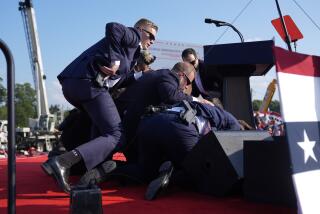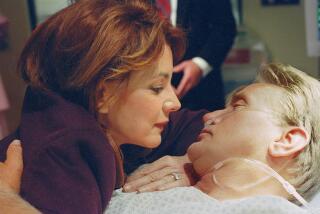White House Situation Room: History’s center stage
- Share via
It’s plenty busy at the White House these days, but somebody should take a moment to light 50 candles in honor of the Situation Room, that suite in the West Wing basement that’s as modest in dimension and decor as it is grand in historical significance.
May marks the Situation Room’s 50th birthday. Rooms are not usually given birthday parties, but if there’s ever a time and place to make an exception, this is it. The “Sit Room,” as insiders call it, has seen an extraordinary amount of drama over the last half a century. And this month, once again, it provided the center stage of history — and yielded one of the defining images of recent memory — as President Obama and his staff crowded around the conference table to monitor the raid on Osama bin Laden’s compound in Abbottabad, Pakistan.
The Situation Room was born in the spring of 1961, after national security advisor McGeorge Bundy brought in a team of Navy Seabees to convert an old bowling alley under the West Wing into a state-of-the-art command center for President Kennedy. The impetus for Bundy’s renovation was the just-failed Bay of Pigs invasion, an attempt to overthrow Fidel Castro in April that went about as wrong as the attack on Osama bin Laden went right. (“A perfect failure,” is how one historian described the Bay of Pigs.)
Bundy believed that the explanation for the disaster partly lay in Kennedy’s lack of unmediated, real-time intelligence from the CIA, State Department and Joint Chiefs of Staff, a deficit that had kept him at arm’s length — and hours behind — the flow of information before and during the invasion. In the future, cables and other data would go directly to the president and his closest advisors in the Sit Room, rather than arriving at the White House secondhand.
Bundy may not have been correct in his analysis of the Bay of Pigs failure. The truth is that Kennedy would have benefited from better information, not more immediate information. Kennedy’s flaw as an executive in those early months of his presidency was a tendency to favor loose organization, with no dependable administrative structure to ensure that he grasped the most pertinent facts of an operation.
Indeed, Bundy seemed to acknowledge this when he drafted a memo to Kennedy on May 16, 1961 — among the first mentions of the Situation Room in writing. Citing a “problem of management,” Bundy asked Kennedy to commit himself to regular daily time slots for national security briefings. “After lunch? Tea? You name it,” he suggested a little cheekily. “But you have to mean it, and it really has to be every day. Will you try it? Perhaps the best place for it would be the new Situation Room which we have just set up in the basement of the West Wing.”
In the popular conception, the Situation Room refers to the conference room usually shown in photographs such as the one issued last week. In fact, it’s a warren of small rooms, including a “surge room” where watch officers sift through diplomatic cables and Internet traffic 24/7. The complex has undergone numerous renovations since 1961. The most recent, completed in 2007, outfitted the conference room with six flat-screen televisions, soundproof glass telephone booths for secure calls and, no doubt, other communication devices about which none of us will ever know unless we join the National Security Council.
The significance of the room in recent American history is almost immeasurable, not just for the role it has played in dramas like the one on May 1 but for what it has meant for the distribution of power in the government. By placing the nexus of the national security apparatus in the basement of the West Wing, Bundy effectively put the chief executive more squarely in the middle of the action, asserting and expanding his command and control.
The challenge for a 21st century president — as it was for Kennedy, even before the Situation Room opened — is to absorb all that information without becoming overwhelmed by it or giving into the temptation to micromanage, as President Carter reportedly did during the Iran hostage crisis.
Based on what the White House has released about the operation against Bin Laden, Bundy’s dream of a crisis center humming along at the center of real-time information seems to have been perfectly realized. Though the White House has not specified exactly what Obama and his aides were watching in the now-famous photograph, it’s clear they were witnessing events unfold as they happened. It seems likely too that the president, had he chosen, could have communicated directly with the Navy SEALs inside Bin Laden’s compound.
The risks of such control for a president are almost as great as the merits. Had the operation failed, Obama would have had a far more difficult time distancing himself from it than Kennedy did from the Bay of Pigs debacle. After all, Kennedy’s best excuse was that the CIA and Joint Chiefs gave him bad information. The Situation Room puts the weight of responsibility more squarely on the president’s shoulders.
As matters turned out, Obama’s gamble paid off. And the Situation Room at 50 — just a few months older than the president himself — is looking grander than ever.
Jim Rasenberger is the author of “The Brilliant Disaster: JFK, Castro, and America’s Doomed Invasion of Cuba’s Bay of Pigs,” published in April. https://www.jimrasenberger.com
More to Read
A cure for the common opinion
Get thought-provoking perspectives with our weekly newsletter.
You may occasionally receive promotional content from the Los Angeles Times.










